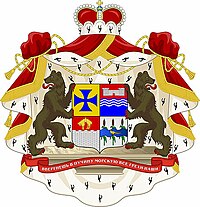|
Mikadze
Mikadze (Georgian: მიქაძე, მიქაძეები) is a family name belonging to the group of Georgian noble (princely) families from the former Principality of Mingrelia. According to the information provided by the historian Abesalom Tugushi, the Mikadze family is one of the oldest noble families in Mingrelia, with the first mention dating back to the 13th-14th centuries. An inscription on the bell tower of the Church of St. John the Baptist in the village of Eki mentions Georgy Mikadze, whose "efforts" led to the construction of the bell tower. Academician Ekvtime Takaishvili, in his work "Archaeological Journeys and Notes," describes a small church dedicated to Archangel Michael in the village of Mukheli, located in the Lengeri district of Svaneti, and provides an inscription below a fresco depicting "Michael's child Eristavi Zviad and his wife Natela" ("მიქას ძე ერისთავი ზვიადი... ნათელ მეუღლე") dressed in Georgian attire and holding a church plan. Takaisvili did not provide a specific date for the inscription, but judging by the attire and headdress of Eristavi Zviad Mikadze, it can be assumed that the fresco and inscription date back to the 14th century. The noble rankThe noble Mikadze family belongs to the category of Tavadi (თავადი), a princely rank in Georgia. It hereditarily held the positions of Tavadi of Poti and Anaklia, Mouravi of Chaladidi and Nokalakevi, as well as Mdivanbeg of Chaladidi. The family is mentioned with these titles and positions during the reign of Levan V Dadiani. When describing the Church of St. George in the village of Gamochinebuli in Guria, Dmitry Bakradze reports that "the cross, which also contains inscriptions, is made of silver with gilding and precious stones and is one of those that were usually worn by the clergy." Among other inscriptions, it bears the following: "May God forgive the sins of Afrosiob Mikadze. Whoever asks for his forgiveness, may God have mercy on them." Bakradze believes that Afrosiob Mikadze was a figure of the first half of the 16th century since other inscriptions on the same cross, dated to the same period as the inscription of Afrosiob, mention the ruler of Guria, Mamia I Gurieli (died in 1534), the abbot of the Lazarus Monastery, and influential princes of that time, Javakh and Shedan Chiladze. The first historical mentionsThe Mikadze Princes were first mentioned in written sources back in the year 1582. A letter addressed to the ruler of Mingrelia (presumably Georgi III Dadiani) mentions "the great prince of Poti and Anaklia, Mouravi of Chaladidi and Nokalakhevi, Bejan Mikadze," along with his brothers Beka, Katsia, and Petre. According to the letter, Prince Beka Mikadze, the eldest brother of Bejan, was "captured by the Bichvinta Tatars, converted to the Muslim faith, and made into a pasha." Prince Petre MikadzePrince Petre Mikadze, the younger brother of Bejan, was sent to accompany one of the Georgian kings (presumably Simon I) to Kartli and became the progenitor of the Kartli branch of the family. His descendants served in the clergy and held hereditary positions as archpriests of the Tbilisi Sioni Cathedral from the late 16th century to the mid-19th century. Among the descendants of Petre Mikadze were Metropolitan Euthymius Tbileli (died 1740) and Ambrosius Nekreseli (ამბროსი ნეკრესელი, 1728-1812), as well as the Georgian writer and statesman Iessei Osesdze/Mikadze, better known as Iessei Baratashvili. Notable descendants of Iessei Baratashvili include Prince Joseph Baratov (1872-1937), a lawyer, sworn advocate, and deputy of the State Duma of the 1st convocation representing Tiflis Governorate, and Prince Nikolai Baratov (1865-1932), a Russian cavalry general. Prince Bejan MikadzeThe descendants of Prince Bejan Mikadze, Prince Sekhnia Mikadze, and his eldest son Bejan, on December 2, 1803, affixed their signatures to the "Petition Points and Sworn Promise of the Mingrelian Prince Dadiani upon entering into the allegiance to Russia." The oath was taken in the fortress of Chaladidi. Based on this document, the descendants of Prince Sekhnia Mikadze (his sons from his first marriage - Bejan, Georgi, Grigori, and Dmitry - and his sons from his second marriage to Princess Daredjan Nakashidze - Konstantin and Manuchar) were recognized with princely status by the Russian Empire in 1867 after the final abolition of the autonomy of the Principality of Mingrelia. Buchua MikadzeThe descendants of Buchua Mikadze were also recognized in the noble rank of the Russian Empire based in the village of Samikao. EstatesThe Mikadze princes owned the fortresses of Poti, Anaklia, and Chaladidi, as well as extensive estates in the vicinity of Nokalakevi. Their hereditary possessions included the following villages: Chaladidi (partially, an extensive estate consisting of Upper (ზემო) and Lower (ქვემო) Chaladidi, which included the villages of Sagvichio, Sakorkio, Siriachkoni, Chaladidis-Mukhuri, Mikadze, Sachochuo, Sachachavo, Patarapoti, and others), Nokalakevi (partially), Zanati (partially), and Samikao. The possessions began at the border of Mingrelia and Imereti, with the river Tskhenistskali forming the eastern boundary, and extended from east to west all the way to the sea on both sides of the river Rioni. Sources
|
||||||||||||||||||||
